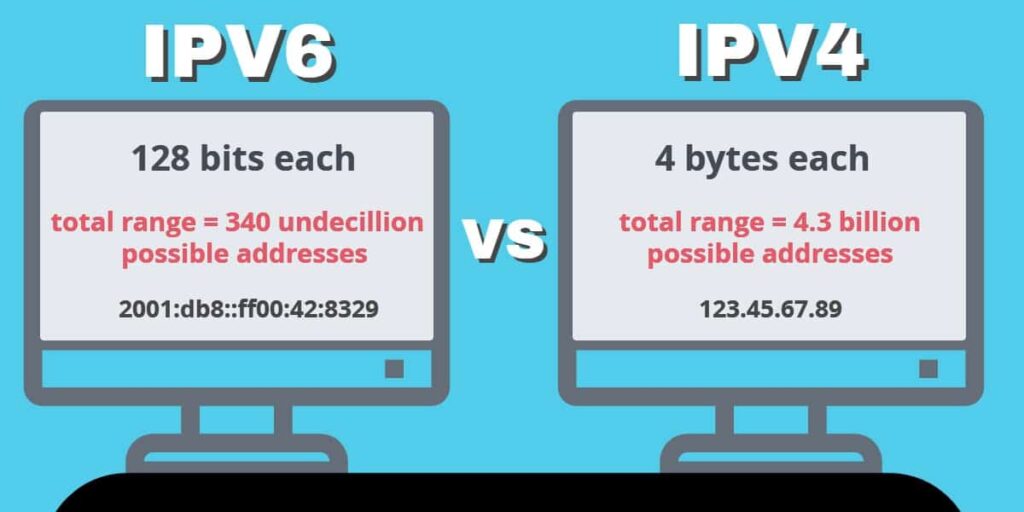
What is IPv4?
Internet Protocol releases 4 stands for IPv4 (Internet Protocol version 4). It’s the technology behind it that allows us to link our phones to the Internet. An IP address such as 99.48.227.227 is allocated to a device accessing the internet (even if it is a PC, Mac, Smartphone or other devices). A database packet must be transmitted across the network that includes the IP addresses of both machines in order to transmit information from one laptop into another via the internet. Now you can easily check your IP by using Prepostseo, what is my IP tool. Computers cannot interact and transmit information to each other without IP addresses. The infrastructure of the internet is crucial.
What is IPv6?
IPv6 is the sixth Internet Protocol update and IPv4’s predecessor. It works like IPv4 because it offers the distinctive numerical IP addresses that are essential for the communication of internet-enabled systems. But one significant distinction is that it uses 128-bit addresses. In a moment, I’m going to clarify why this is essential.
Why are IPv4 (Internet Protocol version 4) addresses not available?
For its web addresses, IPv4 (Internet Protocol version 4) utilizes 32 bit. This implies 2 ^ 32 IP addresses can be supported in full about 4.29 billion. That may sound like a lot, but all IP addresses of 4.29 billion now have been allocated to different organizations leading to the current recession.
However, let’s be evident: the addresses are not yet missing. Many are outdated and in the hands of organizations such as MIT and enterprises such as Ford and IBM. More IPV4 (Internet Protocol version 4) addresses can be assigned and more will be traded or sold (because IPv4 addresses are now scarce), but in the next two years, they will be a scarce commodity until web issues arise.
How is this issue solved by IPv6 (Internet Protocol version 6)?
IPv6 (Internet Protocol version 6) uses 128-bit Internet addresses, as mentioned earlier. Therefore 2 ^ 128 Internet addresses of which, to be precise, 340,282.366.920.938 million and millions and millions or even billions are supported. There are so many references that a hexadecimal system is required for addresses to appear. In other words, IPv6 addresses are more than sufficient to keep the Internet very, very long.
So why are we not simply changing?
It was forecast years ago that IPv4 (Internet Protocol version 4) addresses were depleted, and so the switch was underway for the past ten years. But advancement was slow, with only a tiny proportion of the Web moving into the fresh protocol. Moreover, IPv4 and IPv6 operate mainly as parallel networks— special gateways are necessary in order to exchange information.
The switch requires changing software and routers to help the more sophisticated network. Time and cash will be required. The first true IPv6 (Internet Protocol version 6) network experiment is scheduled for 8 June 2011, World IPv6 (Internet Protocol version 6) Day. Google is testing the IPv6 (Internet Protocol version 6) network and see how the world is reaching the new network, along with Facebook and other major web companies.
How will this affect me?
It doesn’t have a big effect on your lives at first. Most OSs support IPv6, including Windows XP SP 1. Mac OS X 10.2 is supported. Many routers and servers do not promote it though, making it difficult to connect a machine that only runs IPv4 with an IPv6 Address to router or server. IPv6 is also still in its infancy; it is still in need of many bugs and safety problems that could cause a gigantic mess.
No one knows how costly or how long the transition is going to take, but it must be done to make the web work as it is today.
Benefits of Ipv6 (Internet Protocol version 6)
The Benefits of IPv6 although increased address pool is one of the most frequently discussed benefits of IPv6, there are additional significant modifications in technologies in IPv6 which will enhance the IP protocol: auto-configuration of the NAT (Network Address Translation) No more personal address collisions Better multicast routing of simple header format.
Ins IPv6, the computer is checked to see if another computer uses its address when it first begins the local network. If the address is not used, the computer will next search for a local network IPv6 router. If the router is found, the IPv6 address will be requested by the router. Now the computer has an IP address and a default router prepared for communication on the internet.
The network devices will identify the issue if the router falls down and will continue to search for IPv6 to discover the remaining router. In fact, IPv4 is difficult to do that. Likewise, if the router wishes to modify its network routing system, it can. From moment to moment, the devices will question the router and automatically alter addresses. Until all the computers have moved to the new setup, the router supports both old and new addresses.
The Automatic IPv6 setup is not a solution full. Some other items are needed by a computer to efficiently use the web: name servers, a time server, maybe a server file. Dhcp6, therefore, works the same as DHCP, only that one DHCP daemon can serve a big amount of networks due to the routing status of the device.
How Ipv6 is replacing Ipv4 (Internet Protocol version 4)?
When the question arises in your mind What Is My IP, you may go over the web and find it. There you will get numbering like 1.160.10.240 (Ipv4) or 3ffe:1900:4545:3:200:f8ff:fe21:67cf (Ipv6). Ipv6 is replacing Ipv4 because Ipv4 is run out of IP addresses, another cause of replacing ipv4 with Ipv6 (Internet Protocol version 6) is that it is newer better faster, and secure than Ipv4.
The Conclusion
The first version of the IP that has already been used in the ARPAET in 1983 is the latest version of the Internet Protocol. An internet protocol address is also known as the IPV4 IP address. The task force was launched in late 1994 by the Internet Engineer.
IPV4 enables the created easy virtual communications layer across multiple IPV6 devices. Here, IPv4 is a 31 Bit IP address, while IPv6 is 128 Bit IP Address IPv4 provides five distinct IP Address classes.
Related Articles
Discover more from TheLatestTechNews
Subscribe to get the latest posts to your email.














